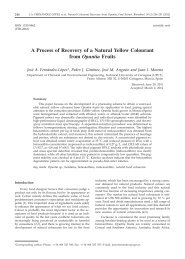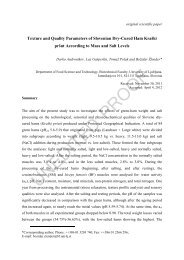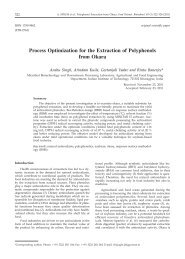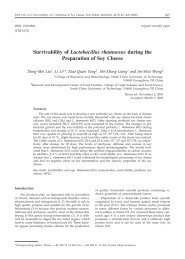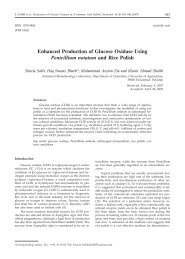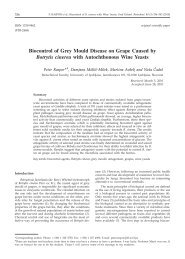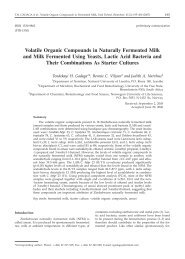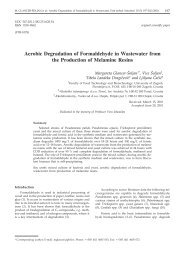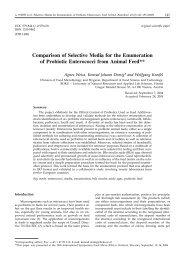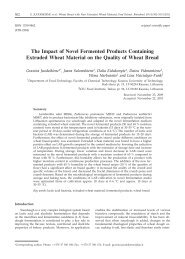Optimization of Bleaching Parameters for Soybean Oil
Optimization of Bleaching Parameters for Soybean Oil
Optimization of Bleaching Parameters for Soybean Oil
Create successful ePaper yourself
Turn your PDF publications into a flip-book with our unique Google optimized e-Paper software.
204 D. [KEVIN et al.: <strong>Soybean</strong> <strong>Oil</strong> <strong>Bleaching</strong> <strong>Parameters</strong>, Food Technol. Biotechnol. 50 (2) 199–207 (2012)neutralized oil occurring in only 4 samples. This indicatesthat the clay used is suitable <strong>for</strong> soybean oil bleaching.The Friedman-type rank test showed that soybeanoil bleached <strong>for</strong> 20 min at 95 °C using 1 % clay had thebest oxidative stability. Fisher’s LSD <strong>for</strong> ranking the sumsshowed statistically significant differences among thesamples (p£0.05), due primarily to the influence <strong>of</strong> temperatureand secondarily to the influence <strong>of</strong> clay content.PCA was also per<strong>for</strong>med on parameters <strong>of</strong> oxidativedeterioration. The first two PCs had an eigenvalue >1and together they explained 80 % <strong>of</strong> the total variance.Score plot (parameters <strong>of</strong> oxidative deterioration and FFA)and loading plot (samples <strong>of</strong> bleached oil) as a function<strong>of</strong> PC1 and PC2 are shown in Figs. 2a and 2b, respectively.Fig. 2a shows a high negative correlation <strong>of</strong> PC1with the indicators <strong>of</strong> secondary oxidation products,while PC2 has a good positive correlation with primaryoxidation products. Fig. 2b shows that although thesamples do not fall into non-overlaping groups based onthe oxidative deterioration, soybean oil samples bleachedwith 1 or 1.5 % clay at 115 °C fall to the left side alongthe PC1. These samples have higher values <strong>of</strong> AV andK 270 . No clustering <strong>of</strong> samples is evident along PC2.These findings suggest that clay amount and bleachingtemperature had a strong influence on the secondary oxidationproducts, but no effect on the primary oxidationproducts.The Friedman-type rank test was applied to all resultsin Tables 2 and 3. It indicated that sample 5 showedthe most efficient bleaching with minimum oxidativedeterioration <strong>of</strong> the oil; this sample was bleached <strong>for</strong> 20min at 95 °C using 1 % clay.The influence <strong>of</strong> bleaching conditions on the contentand composition <strong>of</strong> bioactive components <strong>of</strong> soybean oilwas also examined. These analyses were carried out ona subset <strong>of</strong> samples bleached at different temperaturesusing different clay amounts, since statistical tests <strong>of</strong> theresults showed that the duration <strong>of</strong> bleaching had nosignificant influence on bleaching efficiency or oxidativedeterioration <strong>of</strong> oil. Of course, the sample bleachedusing optimal parameters <strong>of</strong> 1 % clay, 95 °C and 20 minwas also included.Bioactive compounds in vegetable oil, including soybeanoil, contribute to their oxidative stability and nutritionalvalue. The most important bioactive componentsare tocopherols, strong antioxidants with a significant biologicaleffect. Levels <strong>of</strong> total and individual tocopherolsdecrease during neutralization, bleaching and deodorization(6,36). Table 4 presents the content and composition<strong>of</strong> tocopherols <strong>of</strong> selected soybean oil samples. Thedominant tocopherol is g-tocopherol, as reported in previousstudies (8,36,37). It is obvious that the levels <strong>of</strong> a-and g-tocopherol in the neutralized oil decreased duringbleaching. This reduction was greater when increasingclay content and bleaching temperature. The levels <strong>of</strong> d--tocopherol and total tocopherols also decreased, butthere was no significant association with clay content ortemperature. The Friedman-type rank test showed thatthe sample bleached at 105 °C using 1 % clay had thehighest levels <strong>of</strong> individual and total tocopherols. TheFisher’s LSD <strong>for</strong> ranking the sums confirmed that thesamples with different clay content and bleaching temperatureshowed significant differences (p£0.05). In fact,the bleaching parameters found to be optimal based onthe bleaching efficiency and oxidative deterioration <strong>of</strong> soybeanoil (1 % clay, 95 °C and 20 min) did not give opti-Table 4. Tocopherol content and composition <strong>of</strong> bleached soybeanoil samplesw(tocopherol)Samplemg/kga-tocopherol g-tocopherol d-tocopherol TotalNS 87.1 431.7 202.8 721.62 c 62.6 405.1 167.9 635.63 b 54.0 403.6 199.5 657.15 d 47.6 388.2 171.3 607.17 a 51.9 410.6 210.2 672.611 c 42.4 399.2 201.5 643.012 d 41.3 376.1 198.3 615.7NS=neutralized soybean oil<strong>Bleaching</strong> parameters <strong>for</strong> each sample are given in Table 1Samples with different letters in superscript differ significantly(p£0.05)Fig. 2. PCA loading (a) and score (b) <strong>of</strong> the plots <strong>of</strong> the data on oil deterioration during the process <strong>of</strong> bleaching. Samples in b aredescribed in Table 1




